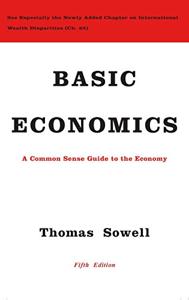
Want to learn the ideas in Basic Economics better than ever? Read the world’s #1 book summary of Basic Economics by Thomas Sowell here.
Read a brief 1-Page Summary or watch video summaries curated by our expert team. Note: this book guide is not affiliated with or endorsed by the publisher or author, and we always encourage you to purchase and read the full book.
Video Summaries of Basic Economics
We’ve scoured the Internet for the very best videos on Basic Economics, from high-quality videos summaries to interviews or commentary by Thomas Sowell.
1-Page Summary of Basic Economics
What is Economics?
When Ghana and Ivory Coast became independent in the 1960s, a bet was made between their leaders. The president of Ivory Coast believed that his country would be more prosperous because it embraced free markets while Ghana had a government-run economy. By 1982, there was no doubt about who won the wager: most people in the poorest 20% of Ivory Coast’s population were better off than most people in Ghana.
Throughout the world, free markets have led to more economic growth and prosperity than any other system. The reason for this is simple: when politicians or bureaucrats control resources, they make decisions based on what’s best for them. In a free market, prices determine who gets goods that are ultimately produced.
Prices
Prices are like messengers that convey information. The news they bring is the availability of resources, or scarcity. Sometimes, as in the case with beachfront homes, there isn’t enough to go around so prices are high. But this doesn’t make them scarce; it just means there’s a lot of demand for those houses compared to supply. If the government capped beachfront home prices or made them free, nothing would change about how many homes are available and instead it would create an artificial shortage where none was before.
Prices can sometimes be a good indicator of the state of things. For example, if there was an increase in iron ore prices, it would tell us that there is more iron ore available than before. This information wouldn’t require people to know anything about the resource itself or how it’s made into steel.
Prices in Action
Generally, the more of a good you buy at one time, the lower its price will be. Conversely, if you want to sell a product for more than it’s worth and make a profit, then produce as much as possible. Through these two rules, we can determine what is really worth our money.
When prices rise, people will do more for themselves than they would if the price were lower. For example, if tomatoes become scarce in one region, farmers from other regions will rush to sell their tomatoes and make a profit. This restores the supply of tomatoes to that region.
Governments sometimes try to control prices, but that doesn’t always work. For example, some countries have rent controls, which can lead to shortages and surpluses in housing. In New York City and San Francisco, as well as in Sweden and France, the laws created a rapid deterioration of apartment upkeep because there was no incentive for landlords to maintain or improve their properties.
The Rise and Fall of Business
In the past, Sears and J.C. Penney were large retailers that had no competition. However, James Cash Penney came up with new ideas about how to run a store chain better than they did at his own store, which was called J.C. Penney’s at the time (and is now known as just “JCPenney”). He didn’t have to convince anyone of anything because he could just prove it by delivering merchandise for lower prices than Sears or JCPenney’s were offering them for their products in order to make more sales and attract more customers who would then be convinced by seeing those results themselves while shopping there instead of somewhere else where they might not get such good deals on goods like clothes or electronics or whatever else he sold in his stores. Once people started coming into his stores to buy things from him rather than going elsewhere first when they needed something, then other companies like Sears and JCPenney realized that if they wanted to compete with him successfully so that their profits wouldn’t go down too much from losing too many sales due to people buying things from Mr. Penney instead of them whenever possible, then those other companies would have no choice but to change what they were doing and start selling some of the same kinds of things for less money so that people would come back again later after having bought something cheaper earlier at Mr. Penney’s store without feeling ripped off or cheated out of any savings opportunities since all three chains are owned by different owners anyway even though all three sell similar kinds of stuff…






